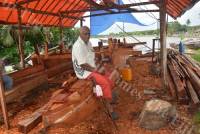Semiti Cama with one of his new drua canoe under construction. Picture: Jona Konataci
Monday, December 05, 2016 by Matilda Simmons
WHEN master navigator Jiujiua Bera first saw the Disney’s animated movie Moana at its premier in Damodar Cinema early this month, the 51-year-old cried.
The Moce, Lau Islander said he instantly remembered times when he and his 15 siblings navigated through the open waters of Fiji, with his father Jimione Paki on the traditional double hull canoe (drua in the iTaukei language) which his family built.
“I kept wiping my tears when I saw scenes of the animated movie showing the Polynesian sailors sailing on the ocean using the traditional way finders. It reminded me of my family when we used to sail across the open seas on the traditional canoe.
“My father used to stand against the hull and direct our path. A scene that remains vividly in my mind is of my mother sitting on the deck and 16 of us siblings huddling around her as we crossed the open waters.
“My father was a lay preacher so when he got transferred to other islands in the Fiji group, we would travel with him on the drua. I remembered when we used to sail even in the bad weather. Such were the memories.”
Mr Bera is a descendant of traditional navigators.
Their island, Moce, located on the borders of eastern Fiji in the Lau Archipelago is known for its inhabitants’ seafaring skills. His father Jimione sailed with his family from the island to settle in Suva (more than 300 km or 172 nautical miles) using traditional methods.
Bera said his father even sailed right to Tonga from Moce.
“To us the ocean is sacred. Our ancestors have sailed through it for many generations. It talks to us and it tells us when we’re nearing land. If you look at its waves, it tells a story. The mana of the ocean is nothing compared with the riches of this world.”
Hence when Disney filmmakers arrived on their doorsteps at Korova settlement in 2009 near the Suva foreshore where they now live, Bera said he and his older brother, Semiti Cama, the eldest son of Jimione were more than happy to tell the story on the secrets of their seafaring skills and the sacredness of the ocean to them.
Such descriptions were given to the Disney directors John Musker and Ron Clements who travelled to Fiji, Tonga and Samoa to gain an insight into the region before embarking on its first ever Polynesian themed animated movie.
According to reports the duo went sailing with Bera aboard a smaller traditional vessel called a camakau to see how it worked.
“They (directors) came several times after 2002; they came with yaqona, a kamunaga (whale’s tooth) and made a sevusevu (traditional approach) for our story. And as we described our ancestor’s story, the filmmakers drew it on the spot, they didn’t even write it. So it was amazing to see how they captured the story.”
In the movie Moana, the ocean played an integral role of directing the heroine, Moana’s path; one would have guessed where the idea came from.
Mr Bera said, before the movie premiered all over the world, the film-makers came to their settlement to show the cartoon to them this year. The visitors made their traditional sevusevu and an envelope containing $300.
Mr Bera said he and his older brother were not concerned about the monetary gain from their knowledge.
“It is free to be given. We believe if we sell our knowledge, the mana associated with it would be lost. Our elders are a silent people, it’s in our culture. Whatever the visitors gave us we will accept it because that’s what our father always tell us — we should accept any traditional approach that comes to us.
“However the person dealing with this should have the foresight to know for it to benefit the recipients.”
He said his family were given $US500 ($F1048) per consultation made throughout the years of making the Moana movie . They are now recipients of a trust under the Pacific Blue Foundation which would fund their drua business.
“We’ve been living at Korova since 1989, when our father settled here, and for those times, through the hurricanes and other natural disasters, we never got harmed either from flooding or other means because the ocean knows us,” he said.
Mr Bera has a last story to tell.
“My brother, the late Metuisela Biuvakaloloma, and my late father once dreamt of starting a drua cruise business but on a trip back from Moce Island on a camakau, Metuisela disappeared. This was in December 1993. His body was never found.
“Eleven years later, in 2004 my father Jimione decided to sail home again and bring another camakau.”
“He was last seen sailing past Moala, the same place Metuisela was last seen on his camakau in 1993. But you know what it doesn’t change our deep connection with the sea. Whenever I take the drua for sailing, I can feel their spirits with me. I feel my ancestor’s heritage upon me. The ocean is more important than the riches gained in this life.”
As in the old saying — “In the fullness of tide, everything is right,” he said with finality.
The Moana movie which drew inspiration from Samoa, Tonga, Fiji, and Hawaii broke box office records last month raking in $80.1 million in its first five days of showing. The movie premiered in Fiji on November 24. It has entered its second week, at number one in North America.
Visit Fiji Times Online to view this article.



